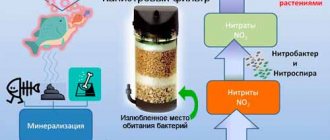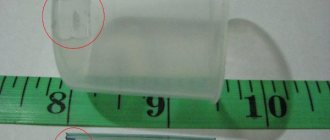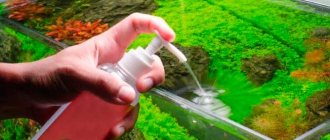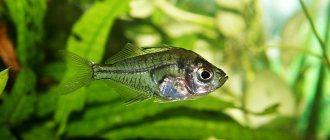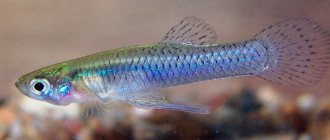When you have fish in your home, you should find out in advance how to clean the aquarium. This seemingly simple activity has its own characteristics and rules that help to restore order in the fish house and not harm its inhabitants. Cleaning is needed not only for beauty, it ensures biological balance, the violation of which leads to irreversible consequences. It is advisable to understand why the water becomes cloudy, what signs indicate the need to clean it, and what daily and general cleaning of the aquarium consists of.
Why does an aquarium get dirty?
Watching the fish calms you down, improves your mood and allows you to promptly notice changes that have occurred in them, indicating that it is time to wash the aquarium. Gradually, the water becomes cloudy, small debris appears in it, and plaque accumulates on the walls, bottom, and soil. These troubles are associated with the life activity of the inhabitants, the presence of algae, and water quality.
The main causes of pollution are the following:
- Overfeeding . If the fish do not eat the food, its remains sink to the bottom and rot.
- Mistakes when decorating . Unprepared soil causes turbidity to appear in the water. Before use, rinse it thoroughly, rinse the shells or figurines used for decoration, and remove fine dust from them.
- Reproduction of microorganisms . Aquarium water necessarily contains bacteria and fungi, which provide benefits by processing ammonia, nitrates and other dangerous substances. But an increase in their number causes a disturbance in the biological balance and the appearance of turbidity. When starting an aquarium, the water needs to be left for several days and only then repopulated.
- Rapid development of algae . This does not mean those plants that sway beautifully and serve as decoration, but lower organisms. They turn the water green and settle on the walls.
- Overcrowding and poor filtration . There are standards regulating the dependence of the number of fish on the volume of water. If there are too many inhabitants, the filter cannot cope, and the amount of waste products increases, causing cloudiness of the liquid.
How to fix it depends on the cause of the problem. You need to analyze the specific situation and decide how to clean the aquarium at home.
How to clean the soil?
Previously, when siphons for aquariums were not commercially available, aquarists had to remove all the soil, rinse it thoroughly, and then put it back again. But this method is very labor-intensive, time-consuming, and it also provoked the death of beneficial bacteria and the active development of pathogenic ones.
Now everything is much simpler. Any aquarium store offers a variety of soil cleaners. Therefore, buying a siphon for an aquarium is not a problem.
We clean an aquarium professionally at home: materials
In all domestic ponds, without exception, a special coating appears on the walls. This makes the glass untidy. To avoid this, algae must be removed. To solve the question of how to clean an aquarium at home, materials such as:
- Plastic scraper equipped with a sharp metal blade. If you don’t have it, you can replace it with regular stationery knives;
- Kitchen sponge;
- Special magnetic tool.
A scraper or a knife purchased at the office is convenient because it removes dirt on glass very well and quickly. If the structure is made of plexiglass, this tool will not work; it will scratch it.
The magnetic tool is ideal for fairly deep containers and those with limited top access. The tool is suitable for modern plexiglass and eliminates the need to drain water before cleaning. The only downside is the overall difficulty in thoroughly cleaning the corners of the container and the edge of the underside of the glass.
The most economical option is to use a standard washcloth, but it forces you to reach all areas with your hand when washing, and its structure is also not suitable for cleaning plexiglass. The algae deposit removed using the selected tool does not need to be caught and then waste time on the cleaning process. The fish will have time to consume a little, and the rest will be removed when drained.
Which type is better
A siphon is an accessory that is difficult for any aquarium owner to do without. All the inhabitants of the aquarium release their waste products into the environment, the decomposition of which can release rotting products - poisonous gases hydrogen sulfide and ammonia.
Important! These gases are harmful to all living organisms in the aquarium.
If in large natural reservoirs this does not have a significant impact on the health of fish and other animals, then in an aquarium, even a large one, the soil must be regularly cleaned of bottom sediments - fish excrement and silt. In this way, you can clean the filler in the form of sand, pebbles, black types and other varieties.
With pump
The aquarium siphon is very simple. It usually consists of a hose with an extension at the end and a pump with a check valve. As a rule, inexpensive siphons consisting of a bulb equipped with inlet and outlet valves and a corrugated hose do the best job. This type is perfect for a small aquarium due to the replaceable end of the hose.
Battery operated
There are electric siphons that run on batteries. They are equipped with a small electric pump that sucks in water. Such siphons eliminate the need to pump water manually. It is most advisable to use them for owners of large aquariums that require a lot of time to clean manually.
Homemade
You can make a siphon for an aquarium yourself quite easily and cheaply. All you need for this is a flexible hose and a plastic bottle. The thicker the siphon hose, the more water it will draw in per second.
Advice! Select the thickness of the hose based on the volume of your aquarium.
For example, for a 100-liter aquarium, a siphon with a hose 1 cm thick is well suited; for an aquarium of a smaller volume, a correspondingly thinner hose is suitable.
To make your own siphon, cut off the top narrow part of the bottle to create a funnel, and then attach one end of the hose to the neck. To work with such a siphon, you need to place its funnel in water and draw air from the other end of the hose to create draft. Usually, the manufacture of such a siphon does not justify itself - fortunately, full-fledged siphons are available on the market at quite affordable prices.
Cleaning scraper
You can try cleaning vertical surfaces with a scraper. If it is not possible to purchase a special tool for cleaning the bottom of the aquarium, do it yourself. You don't need to use a regular sponge to clean. If the pond is not large in size, a regular razor, pre-attached wire or fishing line of the required length will do.
Specialists use bank cards that are no longer in use to thoroughly clean them. If you don’t want to get your brushes and clothes wet, you can easily attach the card to a wooden base. This tool is efficient and does not scratch at all.
Glass cleaning
Even if your aquarium is sparkling clean and tidy, green deposits will still appear on the walls. Over time, it will begin to increase and ruin the entire aesthetics of the reservoir. To get rid of them, you need to take a scraper (with a blade or a magnetic scraper) or a washcloth. If the depth of your aquarium is acceptable for working with a regular scraper, then go ahead. But there are times when getting to the aquarium from above is a big problem or its depth is very large. In this case, it is best to use a magnetic scraper. It does not scratch glass, only if some grain of sand gets between its working surface. The main disadvantage of such scrapers is that it is difficult to process the lower edge near the ground and corners.
You can also carry out this procedure with a household washcloth, but if your aquarium is made of plexiglass, it is better to put the washcloth aside. There is no need to catch all the algae that you remove from the walls from the aquarium; fish will eat it or it will partially merge with the water.
How to clean an aquarium
To properly clean the inside of the vessel, it should be washed using special equipment.
Necessary tools and accessories to clean the aquarium:
- Glass scraper for removing plaque and algae.
- Soil cleaner – siphon.
- Bucket or bowl.
- Net.
The scraper must be selected according to the type and size, relative to the type of aquarium. The most expensive and convenient option is a magnetic scraper that collects dirt by running along the outside of the wall. The pond can be washed with a regular sponge, without impregnation with cleaning agents.
Cleaning without siphon
In the natural environment, there are a large number of participants in the ecosystem: leftover food and fish excrement are eaten by snails, shrimp and bacteria. But to maintain cleanliness in the aquarium, their owners will have to work hard to properly maintain the fish.
Aquariums should be washed carefully and without sudden movements. Remember, interfering with the underwater world causes stress to its inhabitants.
Cleaning of the soil begins with plants and decorative elements . Large pebbles, shells, houses and castles should be taken out and washed under running water. Plants and algae are carefully inspected for defects. If they have yellowed or rotting leaves, they are carefully removed. When cleaning the bottom of the aquarium, it is better to immediately replant the plants, if necessary.
If you clean the soil without a siphon, you can simply rinse it under running water . In this case, the fish should be transplanted into a separate container (basin, bucket).
This procedure looks like this:
- The soil is taken from the aquarium.
- Pours into a bucket.
- It is washed at maximum pressure until all the dirt is washed out.
- It is best to wear a rubber glove and periodically stir the soil in the bucket.
Changing the water in the aquarium
After cleaning the inside of the aquarium, you can start changing the water in it. The volume of water changed depends on the degree of contamination. Typically, about 25% of the total water is replaced. The required amount of water for replacement should be drained to clean the soil. The water is drained using a siphon, following the instructions of the device. It is forbidden to use ordinary running water for replacement; it must be settled in advance. It is recommended to pour new water onto a grotto or saucer that has been placed in advance on the substrate, so that the water pressure does not directly hit the ground and damage it.
How an aquarium siphon works: principles and classification
The main structural elements are the hose and the glass.
The siphon works approximately the same regardless of the model. It is immersed to the bottom, installed vertically. After this, the contaminants fall into the glass and go through the hose into a container prepared in advance. When dirt and turbidity disappear from the glass, it is moved to a new section of the bottom. There are two types of siphons for cleaning an aquarium:
Mechanical - consist of a hose and a transparent glass, which can be replaced with a funnel. There are models where there is no hose. Then, instead of a cylinder or funnel, a mud trap (pocket) is used.
Electric - they run on batteries and are equipped with a compact motor. The advantage of such siphons is that there is no need to drain the water - it is immediately cleaned and returned to the aquarium. Dirt gets trapped.
Mechanical products are cheaper because they are simpler. However, the water has to be drained and then returned back. It is also necessary to monitor the hose so that it does not jump out of the drain container.
In the case of using an electric siphon, all these problems are irrelevant. In addition, the intensity of the water flow is adjustable. True, due to the electric drive, the cost of the model immediately increases, and standard electric siphons cannot be used in aquariums more than half a meter high - otherwise water will flood into the battery compartment.
Experienced aquarists recommend buying devices with a glass at least 20 centimeters high. Then small stones, having been sucked in, will have time to settle and will not fall through the hose into a container with water. It is advisable that the main glass be round or oval in shape: it is safe for plant roots and sinks effortlessly.
Cleaning the filter
It is not recommended to wash the internal filter together with other elements of the aquarium, since a sudden change in the biological balance can cause significant harm to the inhabitants of the reservoir. Once a month, the filter can be disassembled and washed using a toothbrush.
Cleaning manipulations should be carried out in such a way as not to harm the beneficial bacteria that have settled on it. They should not be washed thoroughly. The filter elements are lightly washed in water from the aquarium. If the filter has a ceramic filler, it should not be washed more than once a month.
When not to siphon
- Rarely do they clean aquariums that are completely planted and contain small amounts of small fish and shrimp. The absence of acidification is due to the fact that plant roots penetrate all layers of soil and release oxygen. The released oxygen eliminates the formation of anaerobic zones. The exception is small and weak roots in combination with fine soil laid out in a thick layer. To control the situation, you should periodically check the soil, loosening it with a thin stick.
- It is forbidden to siphon a newly launched aquarium; it will be possible to siphon it no earlier than after 14 days. It is necessary to first grow a colony of nitrifying bacteria in the reservoir; only water changes are allowed.
- It is prohibited to use a siphon to clean herbal aquariums that are densely planted. The siphon will upset the balance, depriving the plant roots of the necessary nutrition. Cleaning helps to raise sludge, which releases harmful substances into the water, including ammonium. Another feature of the herbalist is the nutrient substrates, which are washed away during cleaning, losing their benefits.
Vegetation treatment
If there is living vegetation in an artificial reservoir, then it also requires care and purification. Plants can be cleaned at home, following certain rules:
- Plants do not like transplants.
- Vegetation is not processed during every harvesting operation.
- Spoiled and damaged leaves are cut off.
- Overgrown plants must be removed so that they do not become an obstacle to the free movement of fish.
- Pruning should be done as the bushes grow.
- Overgrown bushes should be thinned out so that they do not interfere with the penetration of light into the container.
- If it is necessary to remove a plant by its roots, the manipulation is carried out as carefully as possible to prevent the rise of turbidity from the substrate.
Cleaning the bottom and soil
A lot of waste accumulates at the bottom of the aquarium. To get rid of them, you can use the same hose with a funnel to drain the water, or you can clean it with a special blower with a rubber or glass tip, lowering it to the bottom.
It should be remembered that this is a very powerful device for removing dirt from an aquarium, therefore, you need to be careful with it so that a fish does not inadvertently get sucked into it.
This way the aquarium soil is cleaned of food residues and accumulated debris. Cleaning must be done thoroughly; there is no need to lower and hold the hose in one place; we collect debris around the entire perimeter of the aquarium. This procedure may require replanting the plants, since the entire soil needs to be cleaned, and not a specific part of it.
Many people are interested in: “How to clean the soil in an aquarium” so that cloudiness does not appear in the water?” The answer is simple - no way. In any case, it will settle after we pour clean water into the aquarium and let it settle for a while.
Popular and trusted brands
Manufacturers of equipment for artificial reservoirs offer a wide range of devices for cleaning aquariums to suit every taste and budget. The main thing when choosing a soil cleaner is to calmly and thoughtfully consider each model, assessing the advantages and disadvantages. Well, if there is no opportunity to purchase models from popular brands, then you can make a siphon for an aquarium with your own hands.
Verified brands:
- EHEIM is a German brand that produces soil cleaners that run on batteries or mains power. The weight of the device is 0.6 kg, while the device quickly and effectively cleans the bottom, returning the purified liquid to the tank. The siphon is designed for reservoirs with a capacity of up to 200 liters and a height of up to 0.5 m. Disadvantages of the device: high cost and rapid battery discharge.
- HAGEN is a company originally from Germany, specializing in the manufacture of electrical devices for soil cleaning. The choice of devices is wide, and every aquarist will be able to choose a device that can carefully and effectively siphon the bottom.
- TETRA is a popular company selling aquarium equipment. There are expensive options in the line of devices, but in general the company produces budget options with good quality, designed for different tank sizes.
- AQUAEL is a Polish brand that produces reliable aquarium cleaners. The main advantage of the brand is the low cost of the devices.
The choice of purifiers is really large and extensive, however, if it is not possible to choose one or another model, then you can build a homemade siphon for an aquarium.
How to clean with hydrogen peroxide?
In special situations, it is necessary to use hydrogen peroxide when cleaning the tank. This composition may be required in such situations as:
- Fish diseases.
- Rapid spread of algae.
- Accidental overturning of a can of food.
- One of the fish died, which went unnoticed.
- The filters did not work for a long time.
The use of the composition will saturate the water with a large amount of oxygen. At the same time, oxidation of organic matter will be observed, a large amount of which is quite harmful to the inhabitants of the reservoir.
To achieve a positive effect when using peroxide, you will need to first dilute the composition in a small container, in a ratio of approximately 1:15. It is strictly forbidden to pour pure pharmaceutical composition into the tank; there is a great danger of burning the living inhabitants. The solution is poured from a syringe in a thin stream into the filter, which will gradually release it into the water and produce its beneficial effect.
After about half an hour or an hour, it will be possible to perform a water change to finally remove all elements of dead organic matter that can cause rot.
Cleaning a marine aquarium
If you want to thoroughly clean an ordinary marine tank, which is usually filled with various decorative elements, you will need to follow these rules:
- Decorations can be cleaned inside the aquarium with a stiff brush or outside with a sponge;
- Modern detergents and household cleaners are not used;
- Be sure to remove all algae damaged by crawling snails or fish. You also need to get rid of eaten leaves. The plant should not complicate the movement of aquatic inhabitants;
- If you do not plan to change the water during harvesting, you need to weed out the bushes very carefully, without raising the turbidity.
To save yourself from regular and tedious weeding, you should get special algae-eating fish. They will keep the water clean for a long time. If you use an additional magnet to clean the aquarium, you can get the best option for cleanliness.
If plants grow very quickly, if they acquire a brown tint, this indicates an unfavorable situation in the reservoir. It will be necessary to take certain measures to effectively control lower plant species.
Preparing a new aquarium
Before launching, a new aquarium undergoes the most thorough cleaning. Before washing the container, leave it indoors for several hours. This requirement especially applies to winter purchases. Glass is a fragile material. Brought in from the cold it can easily burst. While the tank is “breathing”, water is prepared that will be poured into the new house. It is left to stand for at least 48 hours so that all the chlorine evaporates.
The next day you can start washing the walls. Before washing a new aquarium, you need to prepare baking soda and a soft sponge. Take a new sponge. Everything is thoroughly cleaned, not forgetting the corners and seams. Rinse thoroughly to remove soda.
Rinse the soil. If the filler was purchased in a store, then simply rinse it. If the soil was collected from a nearby wild body of water, it must be boiled or calcined to destroy possible infection. But it’s better not to take risks and purchase ready-made filler.
Decorative items are also thoroughly washed. For these purposes, use soda or salt. If the decor contains many small details, then an ordinary toothbrush is used for cleaning.
After all the procedures, half of the settled water is poured, soil is placed, plants are planted, and decorative elements are installed. After a day, add the remaining water, not reaching the edge 6 - 10 cm.
The aquarium is left for several days to ensure the integrity of the structure. As soon as the container has passed the leak test, which takes about 5 to 7 days, the water is drained and replaced with a new one. After this, the home pool is forgotten for 2 weeks. During this time, the aquarium begins to establish its own biobalance. After this time, you can release the fish. But not all at once, but gradually. It is important to remember that for the first 1.5 months after the initial start-up, the water is not changed. They just remove rotten plants, do aquarium tests and monitor the condition of the fish.
